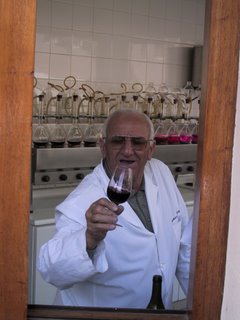Mendoza Sunday 10/9 - Monday 11/9
Sunday
The Alta Montaña trip was probably the highlight of my stay in Mendoza. My Sunday was, by comparison, very relaxing. As is to be expected for a Sunday, the city was mostly deserted. A hot, northerly wind was blowing all of the dust and pollen. The temperature peaked at just over 30 deg C with a humidity of 20% - unusual for the end of winter.
I got to one of the two museums worthwhile seeing in Mendoza, the Museo Fundacional, located on the site of the original Cabildo (town hall), which was destroyed by the 1861 earthquake. The guided tour, in Spanish, raced around the exhibits. The museum covers the history of the region from the "Big-Bang" (the first exhibit is titled "Big-Bang") to the development of the city. The centre piece are archaeological excavations of the cabildo.
Monday
Once again I was in two minds about which activities to do during my last few days in Mendoza. I was spoiled for choice and had some difficult decisions to make. Which wineries should I visit? Would a four hour horse ride leave me unable to sit or walk properly for a week?The kind of tough decisions we all face on a daily basis.
An ad in the window of a travel agency answered my second question. For A$22 (US$7) I could visit two "bodegas" (wineries) and an olive grower in an afternoon. The nearest bodegas are hardly a few kilometers from Mendoza and several have guided tours. You could take bus from the centre out to some of these places. I also saw fliers for bike tours "through the vines", which sounded like a great way to sample the local product. All of the bus tours ran with the same basic format.
- one large winery
- one boutique winery
- and either one of the following: olive oil maker, liqueur producer or chocolate factory
For are large winery we visited Bodega Lopez, which ran a very interesting tour covering the whole process from where the grapes go in to the bottling plant. At the end we tasted a 2003 Malbec from their "Casona Lopez" label. The Malbec grape is what Mendoza is best known for. I do not posses my father's highly experienced pallet, so I cannot be more articulate other than to say I enjoyed it. And for only A$16 (US$5.50) a bottle it seemed like good value to me.

We went on to a small olive oil maker called Olivicola Laur. Like wine, I know nothing about olives or olive oil (except that I enjoy eating them). The first thing I noticed was that the trees appeared to be bigger than the ones I had seen in Mediterranean countries. Apparently this has something to do with the plentiful source of water available, thanks to the Andean snow and a good system of canals. They used both old fashioned presses and more modern equipment.

Or last stop was a very small bodega called Reyter that produced sparkling wine using the "Champagne Method". I was not all that impressed by this tour or what we tasted at the end of it. Maybe I caught them on an off day.

0 Comments:
Post a Comment
<< Home